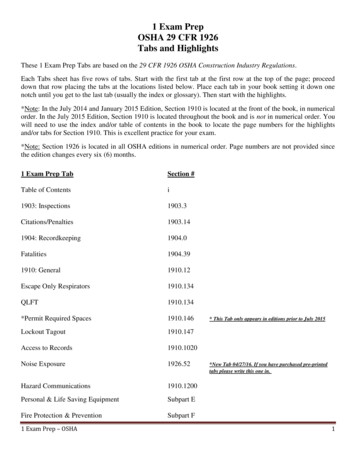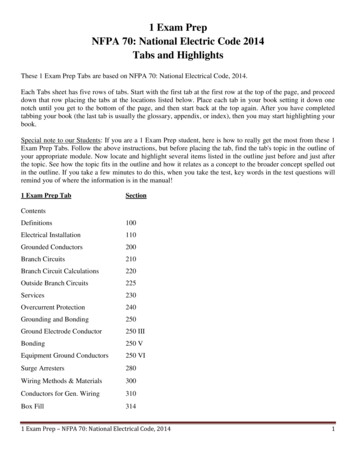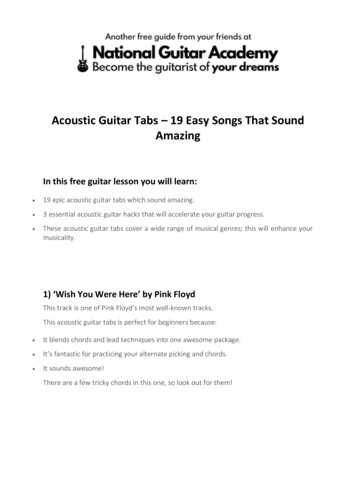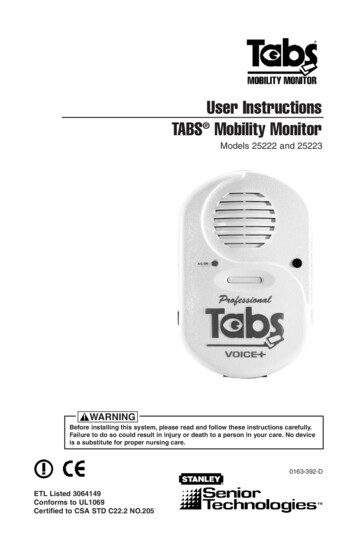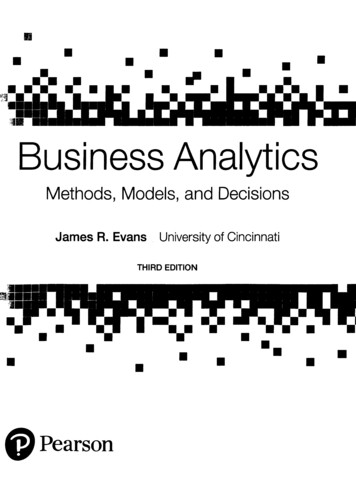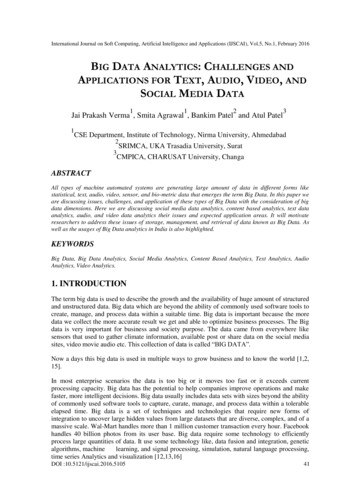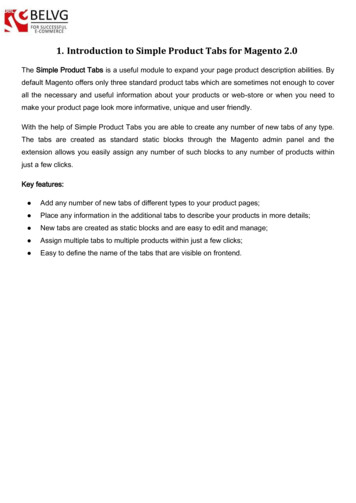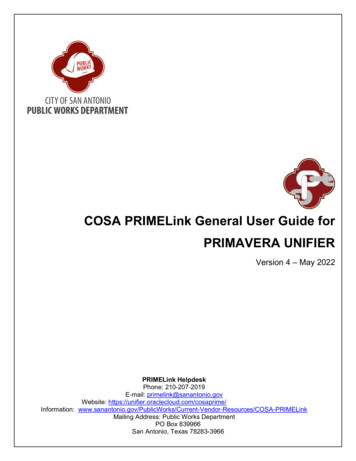
Transcription
Best Practices for Trade Promotionin Consumer-Packaged Goods
Executive SummaryTrade promotions are an essential part of consumer-packaged goods(“CPG”) sales. Promotions can range from trying to boost awareness of aproduct, to taking advantage of times when a given product may be inhigh demand, to unloading inventory before it is no longer usable.However, implementing a trade promotion successfully requires asignificant investment of time and money. Failing to get the desiredtraction that you want could result in a negative return on investment.Compounding this issue is that many CPG manufacturers have the wrongidea of what are “successful” trade promotion metrics. Charting the wrongmetrics and measuring sales of your promotions incorrectly leads to suboptimal performance and ROI. Our goal in this whitepaper is to not onlyprovide a data-driven look at what trade promotions perform successfullybut also show how you can best measure them with your own data. Boththese steps need to be combined to follow a best practices approach.To source the data for this whitepaper, we used a combination of maskeddata from syndicated providers and TABS Analytics proprietarycalculations, using our promotion analysis tools like AccuBase andPromo Insights .Release Restricted TABS Group, Inc. 2020TABS Analytics2
Begin With a New FrameworkA fundamental issue that we see with a lot of companies getting started withtrade promotion analytics practices is that they adhere to an outdatedframework. Right now, most conversations about trade promotions break thingsdown into two areas: Trade promotion management (TPM) Trade promotion optimization (TPO)However, when you take a closer look at these two processes, you see thatmore steps are needed to refine your promotion analysis.For one thing, we suggest converting the two existing areas into: Trade promotion implementation (TPI) Trade promotion measurement (the new TPM) Trade promotion best practice (TPB) Trade promotion planning (TPP) Trade promotion optimization (TPO)In this case, trade promotion measurement uses metrics to figure out whatworks and what doesn’t work with a given project, category, or brand. Then, youdetermine the best practices of a promotion relative to said brand/category. Thenext step is getting data input based on software or another data collectionprocess. The two last elements are planning and optimization. To executethese, you need to create an optimization model that your account manager orsales team can put into practice.Trade promotionmeasurement usesmetrics to figure outwhat works and whatdoesn’t work with agiven project,category, or brand.A New Paradigm For Trade PromotionsHere’s the conventional mindset on trade promotions versus our new spin on things.CurrentTPMTrade Promotion ManagementRevisedTPITrade Promotion ImplementationTPMTrade Promotion Measurement(new)TPOTrade Promotion OptimizationTPBTrade Promotion Best PracticeTPPTrade Promotion PlanningTPOTrade Promotion OptimizationRelease Restricted TABS Group, Inc. 2020TABS Analytics3
The Metrics You NeedConsidering this new mindset, what exactly is the best way to measure yourpromotion’s success when it goes into action?A lot of well-meaning companies get things wrong here. They may try to focuson things like retail dollars or shipment dollars. The problem here is that it canbe difficult to equivalize the product into volume. For example, if you areselling paper products, it may be in rolls or sheets. If you were selling a foodproduct like candy, it may be in pounds. If you were to be working withbeverages, it may be in cases.Our recommendation, in this case, is to focus on measuring consumer units.This metric allows you to easily convert things into whatever else you need,whether it’s shipments, retail, or cases. One way to convert this is intoconsumed factory shipments (CFS). We define this as our net wholesaleprice, or whatever you’re selling the product to a retailer to, times the numberof retail units generated. For example, say your product had a net cost of 3.50 to retailers and you generated 600 units. This is 2,100 in CFS. That’skey when we talk about gauging ROI moving forward.Another metric that is arguably the most important, despite its underutilization,is the idea of what we call the incremental factor. The incremental factor is thenumber of incremental units generated divided by the number of total unitssold. What this does is show us if you were to eliminate promotions tomorrowon a total company basis, what percentage of business you would be at risk.For example, let’s say that you were doing three different promotions andmoved 400, 350, and 600 units, respectively, during those promotions. Bycomparison, the baseline sales (units sold that were not on promotion) wouldbe 100 units. Over a 10-week period, we would see 1,050 incremental unitssold versus 1,000 baseline units sold. This makes the incremental factor 51%(1,050/2,050). That means if you were to stop promoting, 51% of yourbusiness would be at risk of going away.Release Restricted TABS Group, Inc. 2020TABS Analytics4
The ROI QuestionHow does this translate to a best practice for measuring ROI? You can usethe incremental CFS generated by a promotion dividing by what you spenton the promotion. As a result, you can see the ROI based on internalmargins for your brand or category, without having to factor in all internalcosts like logistical costs, cost of goods, etc. So, you’ll have a metric that’seasier to share and understand, which makes the profitability question a lotmore accessible. The goal now becomes that for each dollar you spend ona promotion, you need to generate two dollars in that incremental retailconsumption, or three or whatever threshold ROI applies.Following our previous example, let’s say we spend 1,500 on the threeevents and they generate 3,675 cumulatively. That generates a 2.4 spendratio, or ROI ( 3,675/ 1,500), and if your internal gross margin is greaterthan 42%, you know you were profitable (1/.42 2.38). Our method savesyou time from trying to find out the profitability of each event. What youneed to know is whether you are making money or not and the spend ratioand gross margin comparisons will tell you this.How To Gauge Trade Promotion SuccessEveryone wants a successful trade promotion, but many don’t understand what it takes to actuallydetermine if something is successful or not. Here are some of the key notes to keep in mind.Focus on consumerunits:This metric allows you toeasily convert the productyou are working with,whether it’s food, papergoods, or anything in theCPG segment.Use consumed factoryshipments:This metric is how muchyou’re selling the productto a retailer for multipliedby the number of retailunits generated.Use the incrementalfactor to gauge ROIThis shoes how muchprofit you would lose ifyou were to halt allpromotions tomorrow.Don’t get too focusedon individual profitabilitynumbers:The main question is if youare making money on yourpromotions or not. Theincremental factor willshowcase this.Release Restricted TABS Group, Inc. 2020TABS Analytics5
What is Data Harmonization?So, calculating an ROI using the right metrics is a key for success, but thereis another critical part of sales promotion analysis that rarely gets discussed:data harmonization. For example, a lot of companies talk about the idea ofanalyzing big data in terms of leveraging software tools, but that isn’t nearlyas effective if the data isn’t harmonized properly. To do so, you shouldharmonize: Event-level spendingAd performanceAd imagesOther related dataHaving data harmonized allows you to put the best practices into action andget to the critical insights. This includes understanding promotional dates,your promoted brand sizes and event-level spending.Redefining this process of harmonization is also important. Manymanufacturers believe in starting with their implementation beforeoptimization. Our counterpoint is to go to the measurement step right away.This lets you figure out exactly what your impact on sales is compared towhat you are spending. After that, you can combine planning andoptimization, and implement software to manage all these promotions. A lotof companies are starting backward by buying software to manage the datarather than learning how the data works, then using software to do the job atscale.Release Restricted TABS Group, Inc. 2020TABS Analytics6
Busting Myths On TacticsMany companies may already have tradepromotion tactics that they favor, and on thesurface, they feel that they’re successful.However, as the prior sections point out, a lot ofcompanies are basing their understanding onfaulty metrics and measurements. When we applyour methodologies to the data, what tradepromotion tactics show up as the best? Here’s arapid-fire look at our insights here. Displays aren’t particularly effective if there areno price discounts available. Designing them,implementing them, and managing them comeswith a high dollar cost and time toll that rarelypays off. The one exception is the consumablessector. One side benefit of displays is the abilityto hold extra inventory for a hot promotion, butthat’s hardly worth it. Bonus packs generally do not pay out. Even withwell-paired items, you’re rarely going to get a lotof sales, and will likely end up with many “noshipments” after the end of the promotion. If youwant to do a variant of this method, BOGO is thebest option. However, you absolutely can’t overship.The Facts OnTrade PromotionTacticsWe analyzed maskeddata from providers tosee how different tradepromotions stacked upagainst each other.Here are some of thewinners and losersfrom our findings. Loyalty cards don’t equal loyal shoppers. In fact,it’s just the opposite. Shoppers that buy theseare willing to go to many different stores in orderto pursue the best deals. With this said, they arealso heavy shoppers by nature, so if you havethe best deals, it can work. BOGOs can work well to generate lift, butpercent off generally works better. This isespecially the case when we talk about higherprice points. Note that if you do go for giving apercentage off, it needs to be above 20% to getsignificant traction. Buy 2, get 50 (BOGO50) generally doesn’t workwell. In the retail drug channel, this is common,but it doesn’t give the customer savings thatBOGOs or percent off do. Customers are savvyto this and pass these promotions by. It is better to do fewer, deeper discountpromotions versus more moderate ones. You willbe more efficient on your fixed ad costs this way,and the demand curve steepens the deeper thediscount.Winners:Percentage off:Customers respond best to these types ofdeals, but you need it to be above 20% toget customer interest. This is especiallyimportant if you are selling a product likesupplements at a higher price point.BOGO:BOGO is also effective for customer lift,but gets less useful the higher the pricepoint gets.Loyalty cards:Success here is a bit of a tossup. Loyaltycard owners are the least loyal shoppers,but they are also heavy shoppers. If youhave the best deals, they will make goodcustomers for you.Losers:Bonus packs:You can come up with a smartcombination, but the customerinterest just isn’t there. Use BOGOor percent off instead.No-price displays:The added inventory space is nicefor a hot promotion, but there’sgenerally too much work for notenough gain.Buy 2 get 50:The added inventory space is nicefor a hot promotion, but there’sgenerally too much work for notenough gain.Release Restricted TABS Group, Inc. 2020TABS Analytics7
Executing Trade PromotionsAt this point, we’ve been focusing on the planning stage. Now, we needto talk about best practices for execution. One common concept that alot of retailers buy into is either asking to hold their penny profit ormargin on a regular basis. The problem is this isn’t realistic and is a bitof a pessimistic view. Lowering the price will make it more difficult to getthe lower margins you need to maintain your profits. The end goalshould be to get a break-even scenario to guarantee making money inthe total value chain. Manufacturers know the costs of the goods, sothey have more information than retailers do.When that step is taken, how do you end up distributing the discounts?There’s a real struggle here in ensuring that the manufacturer andretailer make money this way. Our formulas show that a manufacturersubsidizes a discount in a proportion to the profit they have in a valuechain. So, if a manufacturer makes 75% of the profit in said chain, theycover 75% for each dollar’s discount. This means they may need to: hold the margin create a larger margin to the retailer have the retailer accept a lower marginThe key in executing trade promotions is to make it a win-winproposition for both retailers and manufacturers.We should also begin to talk about some of the self-defeatingtendencies that hamper the ability to really make money off a promotion.The key in executingtrade promotions is tomake it a win-winproposition for bothretailers andmanufacturers.First, is the concept that trade promotion spending is an inherently badthing that is going to tarnish the image of a brand. However, effectivetrade promotion spending can increase profits, as some of our earlierexamples have shown. The main issue here is manufacturers not caringabout what their retailer partners make. This is a self-defeating mentalityto have.There are also barriers on the retailer’s end. For example, some retailersare unwilling to be flexible with margins. Others take deductions andapply them across the board to all manufacturers. This is a mistakebecause there are some brands that just inherently get low responses. Itdoesn’t really make sense to promote these. Instead, those promotionaldollars should be deducted from larger or more responsive brands.However, this mentality can go too far in the other direction as well.Some retailers decide not to promote smaller sales brands because theybelieve that these won’t help them meet the goals of creating a setamount of volume via a given block of ads. However, this doesn’taccount for incremental ad blocks. As a result, larger manufacturersthrow all their brands into an ad block, but the “kitchen sink approach”doesn’t create a lot of lift.Release Restricted TABS Group, Inc. 2020TABS Analytics8
What Does It Take For Your Trade Promotion To Succeed?Let’s sum up a basic roadmap that you need to take in order to create a successfultrade promotion for your business.Adjust your frame of thinking:Our model for trade promotions is more complicated for a reason. Thereare a lot of steps companies are missing whenit comes to iterating and improving their promotions.Using the right metrics:Concepts like incremental factor and consumed factory shipments areeasily translatable to different products, rather than needing to create anew metric for each type of product your company sells.Being data-forward but not using software as a crutch: Eventually,you will need data software for long-term promotion efficiency and properdata harmonization. However, it’s important to learn how the data youhave works first before making this investment.Trendy does not equal successful:There are plenty of concepts like buy one, get 50 or bonus packs thatmay be popular, but don’t actually show meaningful success. The sameapplies to models like live accrual.Working with your partners:Retailers and manufacturers can’t afford to be selfish. Transparency andtrust are key to creating promotions where both sides benefit.Shifting Your Trade Promotion ParadigmOur findings show that trade promotions are an important part of creatingprofits across the board CPG manufacturers. However, a lot ofmanufacturers are holding onto outdated or false tenets when it comes totheir overall strategy. Our recommendation is a two-part shift to: Ensure that manufacturers and retailers are working together to createthe most profit possible. Change from conventional metrics of success to more accuratefigures, using data at every step of the way.While your specific goals for a promotion may differ, the ultimate endgameis increased profits for your business. The practices outlined in thiswhitepaper are key for getting to that point and being able to analyze thesales and promotion data more effectively.Release Restricted TABS Group, Inc. 2020TABS Analytics9
About TABS AnalyticsTabs Analytics, founded by Dr. Kurt Jetta in 1998, is a technology-enabledanalytics firm servicing the consumer products industry. Our mission is tosimplify and improve the way analytics is conducted through analyticalinnovation, which translates into a competitive advantage for our clients. TABSis the leading outsourced sales and marketing analytics firm in the consumerpackaged goods (CPG) industry.For more information about TABS Analytics services or this white paper, pleasecontact Robert Baldwin at robertbaldwin@tabsanaltyics.com.Release Restricted TABS Group, Inc. 2020TABS Analytics10
Trade promotion management (TPM) Trade promotion optimization (TPO) However, when you take a closer look at these two processes, you see that more steps are needed to refine your promotion analysis. For one thing, we suggest converting the two existing areas into: Trade promotion implementation (TPI)
